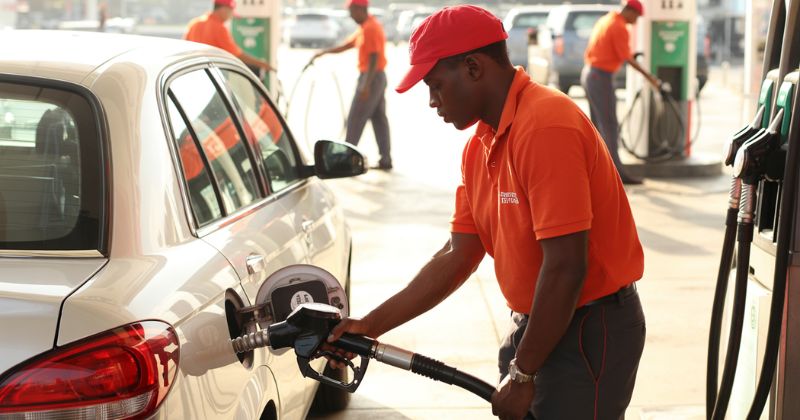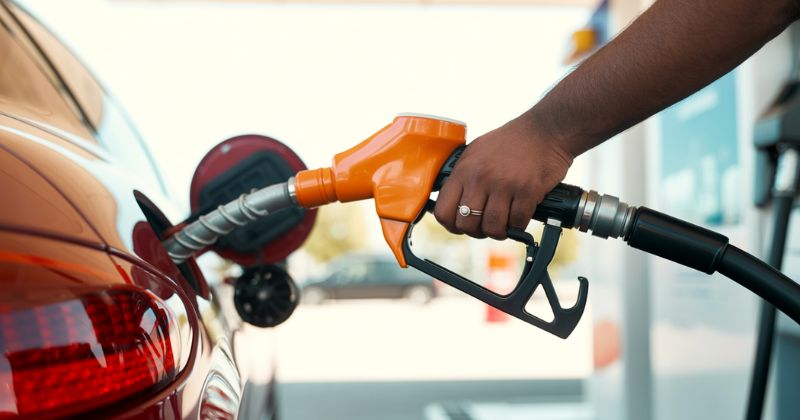
The Department of Mineral Resources and Energy (DMRE) has released the official adjustments to South Africa’s fuel prices, which will take effect from Wednesday, 7 May 2025. These price changes follow a period of volatility in global oil markets and currency fluctuations, and are part of the regular monthly review of fuel pricing mechanisms in the country. The announcement comes at a time when household budgets remain under pressure from rising food prices and stagnant wage growth, making any reprieve at the fuel pumps a welcomed development for consumers.
Key Takeaways
- Petrol and Diesel Prices Drop Despite Rand Weakness: South African motorists will benefit from a fuel price reduction in May 2025, with both 93 and 95 unleaded petrol decreasing by 22 cents per litre, and diesel dropping by up to 42 cents per litre, largely due to falling global oil prices.
- Global Oil Market Volatility Offsets Local Currency Pressure: A significant decline in Brent crude oil prices, from $71.04 to $66.40 per barrel, helped offset the rand’s depreciation against the US dollar, which had pushed average exchange rates to R18.84 during the review period.
- Fuel Levies Hold Steady, But Carbon Tax Increases Slightly: While general fuel and RAF levies remain unchanged, the carbon fuel levy rose by 3 cents per litre, affecting the total tax burden on both petrol and diesel from April onwards.
About Arcadia Finance
Apply with confidence through Arcadia Finance. No application fees, access to 19 trusted lenders, all NCR-compliant. Quick, reliable, and tailored to your financial needs.
Global Oil Price Decline and Rand Weakness Shape Local Fuel Costs
During April, international oil markets experienced a sharp downturn, primarily driven by geopolitical developments including tariff escalations and rising tensions related to global trade. The economic strain was notably triggered by trade policies imposed by United States President Donald Trump, which fuelled fears of a global economic slowdown and subsequently led to a fall in demand expectations for crude oil. These trade tensions have reignited fears of another wave of inflation, particularly in developing economies where fuel imports play a central role in cost structures across multiple industries.
Simultaneously, the South African rand experienced some depreciation against the US dollar amid these market shocks. Although the weaker rand generally contributes to higher local fuel costs, the steep decline in oil prices managed to offset this, resulting in an overall drop in pump prices for the month of May. The net effect for South African motorists is a mixed outcome: cheaper petrol and diesel in the short term, but lingering uncertainty over the rand’s stability continues to cast a shadow over future fuel pricing trends.
South Africans entered May with anxiety already building. Fuel Price Hike Concerns is the story behind the figures, highlighting economic fears and consumer reactions.

Breakdown of Fuel Price Changes for May 2025
Despite upward pressure from currency depreciation and adjustments to fuel levies, motorists in South Africa can expect a reduction in petrol and diesel prices this month. The official changes are as follows:
| Fuel | Type | Change |
|---|---|---|
| Petrol | ||
| 93 Unleaded Petrol | Decrease of 22 cents/litre | |
| 95 Unleaded Petrol | Decrease of 22 cents/litre | |
| Diesel | ||
| 0.05% Sulphur (wholesale) | Decrease of 42 cents/litre | |
| 0.005% Sulphur (wholesale) | Decrease of 41 cents/litre | |
| Other Fuels | ||
| Illuminating Paraffin (wholesale) | Decrease of 31 cents/litre | |
| Liquefied Petroleum Gas (LPGAS) | Increase of 46 cents/kilogram |
While diesel prices have seen the steepest declines, this is particularly significant for the logistics and freight sectors, where diesel accounts for a major portion of operational costs. These cuts may offer temporary cost relief to transport operators, food distributors, and agricultural businesses already grappling with input cost inflation.
Market Factors Behind the Adjustment
Local fuel prices are heavily influenced by international benchmarks, particularly global oil prices and the rand-to-dollar exchange rate. During the month under review, the average Brent crude oil price dropped significantly from US$71.04 per barrel to US$66.40. This decline was largely attributed to fears surrounding an impending global recession and dampened demand projections for petroleum products.
In addition, the Organisation of the Petroleum Exporting Countries and its partners (OPEC+) made an unexpected decision to raise oil production, which further pressured prices downward. As a result, the average international prices for petrol, diesel, and illuminating paraffin all declined during this review period. Analysts warn, however, that this downward trend may be short-lived if global demand rebounds faster than expected or if OPEC+ reverses course with output cuts.
Curious how consumers are reacting? Read how South Africans Celebrate R2.90 Petrol Price Drop for the full story of the latest relief at the pumps.
Currency Volatility and Rand Performance
The weakening of the South African rand further complicated the pricing calculations. At one point during the month, the rand-dollar exchange rate approached R19.90, spurred by global uncertainties and domestic political tensions, particularly speculation surrounding the Democratic Alliance’s potential withdrawal from the Government of National Unity.
Over the full review period (from 28 March to 1 May 2025), the average rand-to-dollar exchange rate was R18.8382, compared to R18.2957 in the previous month. This depreciation increased the contribution to Basic Fuel Prices (BFP) by:
- 29.13 cents per litre for petrol
- 30.34 cents per litre for diesel
- 30.24 cents per litre for illuminating paraffin
The currency impact effectively muted some of the benefits of lower oil prices, highlighting the delicate balance between international commodity markets and local macroeconomic stability. For motorists, it means that every cent of reprieve is vulnerable to external economic shocks or local policy uncertainty.
Changes to Fuel Levies and Tax Structure
In his Budget Speech delivered on 12 March 2025,the Minister of Finance confirmed that the general fuel levy will not increase, holding steady at 396 cents per litre for petrol and 384 cents per litre for diesel. Likewise, the Road Accident Fund (RAF) levy remains fixed at 218.00 cents per litre for both petrol and diesel.
However, adjustments were made to the carbon fuel levy, which increased by 3.00 cents per litre, bringing the total to:
- 14 cents per litre for petrol
- 17 cents per litre for diesel
These new levy figures took effect on 2 April 2025, resulting in revised total fuel levies of:
- 399.00 cents per litre on petrol
- 387.00 cents per litre on diesel
The slate levy, used to stabilise fuel prices during periods of under-recovery, remains at zero cents per litre for both petrol and diesel in May. This unchanged slate levy may reflect the government’s cautious stance on intervening too heavily in pricing structures amidst mounting fiscal constraints and calls for energy pricing reform.
The official price is only part of the story. Discover how New Fuel Taxes Take Hold as State Company Faces Major Financial Crisis is impacting South Africa’s petrol price movements and the wider economy.

Pump Price Comparisons: April vs. May 2025
Below is a comparative overview of fuel prices between April and May 2025, reflecting official changes in both inland and coastal regions. Note that diesel prices reflect wholesale values, and final pump prices may vary by service station.
It’s worth noting that inland prices are consistently higher than coastal counterparts due to added transport and distribution costs. Consumers in landlocked provinces such as Gauteng and Free State continue to carry a heavier fuel burden relative to those in coastal cities.
Inland Region
| Fuel Type | April Price | May Price |
|---|---|---|
| 93 Petrol | R21.51 | R21.29 |
| 95 Petrol | R21.62 | R21.40 |
| Diesel 0.05% (wholesale) | R19.32 | R18.90 |
| Diesel 0.005% (wholesale) | R19.35 | R18.94 |
| Illuminating Paraffin | R13.36 | R13.05 |
| LPGAS (per kilogram) | R37.77 | R38.23 |
Coastal Region
| Fuel Type | April Price | May Price |
|---|---|---|
| 93 Petrol | R20.72 | R20.50 |
| 95 Petrol | R20.83 | R20.61 |
| Diesel 0.05% (wholesale) | R18.53 | R18.11 |
| Diesel 0.005% (wholesale) | R18.59 | R18.18 |
| Illuminating Paraffin | R12.36 | R12.05 |
| LPGAS (per kilogram) | R34.61 | R35.07 |
Although LPGAS users face a noticeable price hike this month, this fuel type remains a vital alternative energy source for many lower-income households and businesses that rely on gas for cooking, heating, and industrial processes.
Overall, the May 2025 fuel adjustments reflect a complex interplay of global oil dynamics, currency turbulence, and local tax policy, all of which will continue to shape South Africa’s energy affordability in the months ahead.
Whether you’re planning a trip or commuting to work, fuel prices directly impact your wallet. Discover just how much in our full breakdown of the Cost of Travel in South Africa and how to navigate it wisely.
Conclusion
The fuel price adjustments for May 2025 bring modest relief to South African consumers amid continued economic uncertainty. While global oil price declines have allowed for reductions in both petrol and diesel costs, the positive impact has been tempered by a weaker rand and minor tax increases. These developments highlight the ongoing sensitivity of local fuel prices to international market movements and domestic fiscal policies.
Fast, uncomplicated, and trustworthy loan comparisons
At Arcadia Finance, you can compare loan offers from multiple lenders with no obligation and free of charge. Get a clear overview of your options and choose the best deal for you.
Fill out our form today to easily compare interest rates from 19 banks and find the right loan for you.



